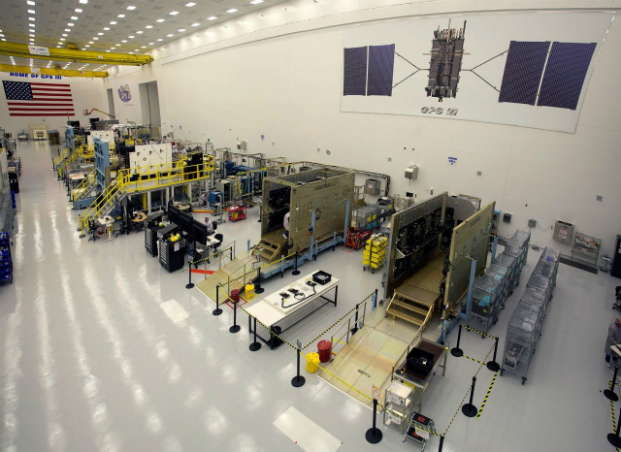
Lockheed Martin's GPS III Processing Facility near Denver, Colo. Lockheed Martin photo.
The Air Force knows it needs to view space assets as a holistic enterprise, but to succeed, the service first must figure out how to leverage the defense industry.
That’s why officials want to stand up a team, led by a federally funded research-and-development center, that can bring companies together to work on programs in new ways, said Col. Russell Teehan, portfolio architect at the Air Force Space and Missile Systems Center, at a Feb. 22 AFA Mitchell Institute breakfast on Capitol Hill.
An enterprise approach would address common problems across multiple missions from the start, rather than designing individual systems for specific missions and later trying to connect them or make them multipurpose. It’s the same tactic the Air Force is using to develop a command-and-control network to replace legacy aircraft.
Teehan envisions turning to a procurement model led by an integrator for each aspect of space assets. Those managers would work with companies to build standardized products that can be mass produced, will connect to commercial and coalition assets, and are affordable.
“Enterprise planning allows us to start to look at, what are the themes across different mission areas?” Teehan said. “Get away from one-off systems. Get into large-scale production at the bus, at the payload, at the ground, at the data, at the software level. So you’re looking for efficiencies across different mission areas.”
Easily available, more affordable commercial technology could be an ideal for integrating disparate systems together, he added.
Teehan isn’t sure whether a consortium, an indefinite-quantity order, or a cooperative research-and-development agreement is the best way to bring industry on board. But he told attendees some top priorities include finding new command-and-control capabilities, ways to synchronize multiple layers of orbiting assets, and prototyping how the operations floor itself connects future technologies.
Instead of building satellites to perform one job, Teehan suggested, what if satellites could hop between orbits for different missions
“Imagine the dynamic architecture you can create if you can create maneuver in the domain,” he said, adding: “We can find ways to proliferate buses, work with commercial architectures, but if we don’t have proliferatable payloads that can be disseminated into these architectures—it’s killing us.”
Michael Dickey, the director of Air Force Space Command’s enterprise strategy and architectures office, noted systems need the ability to defend themselves and “get out of the way” when attacked. He declined to provide specifics about how that might work.
To build a flexible, long-lasting network of space assets, Teehan said the Air Force must spread its command-and-control enterprise outside US borders.
“When someone tells you they’re looking to deny your capability into the theater, the natural tendency is to disconnect from the theater and then protect yourself,” he said. “The key is to prototype into those theater demonstrations, so that we build resilient capabilities, so that as other elements of the architecture come and go, you can still [command and control] that capability in theater.”
As the Air Force looks for hardware and software that can link weather, intelligence, and other military systems on orbit, Teehan warned against moving through the procurement process too quickly for speed’s sake.
“You can acquire quickly and still acquire stupidly,” he said. “You’re running with scissors.”